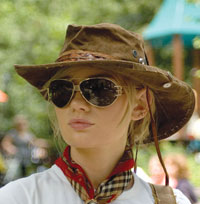Cover Up
The most effective method of avoiding undue sun exposure is to stay indoors, but most of us love the sun too much. Does chemical sunscreen or sunblock provide a solution? Not likely, says Harvey Schakowsky, owner of Solar Protective Factory, a Madison, Wisconsin-based manufacturer of Solarweave sun-protective fabrics and garments. For one thing, not all of these chemical products are designed to block both UVA and UVB radiation. Further, says this 18-year industry veteran, many of these lotions and creams are “insufficiently tested and very seldom perform up to the level of the claims that are made for them.”
And there are plenty of consumers who shun sun protection altogether—leading to conditions from cataracts to rosacea to premature aging. Melinda Damico, co-owner of the New Jersey company PAZ, which makes sun hats, says some 70 percent of the American public does not use any form of sun protection.
Sun-protective clothing—from wide-brimmed hats to long-sleeved bathing suits and hoodies—takes UV blocking to new heights. The clothes provide a barrier against rays (and resulting skin conditions). There’s no forgetting to reapply sunscreen, and there’s significantly less waste and cost than buying bottle after bottle of lotion. Also, many of those lotions contain petrochemicals that organic-minded consumers would rather avoid.
Chemical Blockers?
Marta Phillips, owner of SunGrubbies.com, acknowledges that sun-protective clothes may be derived from petroleum and contain chemicals, but they won’t be absorbed by the skin. Polyester, nylon and Lycra are three popular materials used for these specialized garments. Polyester fibers not only absorb UV, they can be shaped to help wick moisture, thus keeping skin cooler. She says that dark-colored, heavy denim may be the best choice. She does not sell denim, but carries a wide selection of pants, jackets and hats, as well as unusual items such as cover-ups, sun gloves, sun sleeves (for truckers and other professional drivers whose left arms are often exposed to UV rays), and nose scarves, which, Phillips says, are often more comfortable than prostheses for customers who have lost their noses to cancer.

As important as the fiber may be, the effectiveness of any sun-protective garment depends at least as much on the tightness of the weave or knit. When designed properly and tested adequately, these garments become medical devices, says Shaun Hughes, founder and president of Sun Precautions, Inc., in Seattle, Washington. Hughes discovered the need for such products the hard way when, at the age of 26, he was diagnosed with a melanoma.
An avid downhill ski racer and sports enthusiast, Hughes’ lifestyle was active and healthy, but his lifetime of exposure to the sun was not. “Unfortunately, even in a place like Seattle, which is not known for sunny weather, overexposure to UV rays can pose a potentially life-threatening danger,” he says. For the past 15 years, his company has been selling sun-protective clothing under the brand name Solumbra.
Best Defenses
The sun-blocking clothing industry has developed its own voluntary standards that show such clothing can effectively block more than 97 percent of both UVA and UVB rays. But Schakowsky warns, “Not all manufacturers purporting to offer such products have actually followed the standard’s protocol.” As a former chairman of the American Society for Testing and Materials (ASTM) committee that created what is popularly known as the Ultraviolet Protection Factor (UPF) rating system, he explains how this system works.
There are three levels of effectiveness—Good (rated 12-24 and blocking 93 percent of UV radiation); Very Good (15-39, blocking 95 percent); and Excellent (40-50+, blocking more than 97.5 percent). To qualify for these ratings, Schakowsky says a fabric should undergo a rigorous procedure that includes being “washed and dried 40 times’ and “subjected to 100 hours of UV exposure before being tested throughout the UVA and UVB spectrum.”
The product should bear the lowest rating achieved during testing. If there’s one slogan the sun-protective clothing industry agrees on, it’s this: there’s definitely no such thing as a healthy tan.
Understanding UV Radiation
The World Health Organization (WHO) identifies three forms of ultraviolet (UV) radiation—UVA, UVB and UVC, each distinguished by its wavelength.
Short-wavelength UVC is the most damaging type, but it is completely filtered by the atmosphere and does not reach the earth’s surface. Medium-wavelength UVB is very biologically active but, according to WHO, cannot penetrate beyond the superficial skin layers. It is responsible for delayed tanning and burning, as well as exacerbating skin aging; it also significantly promotes the development of skin cancer.
Relatively long-wavelength UVA accounts for approximately 95 percent of the UV radiation reaching from the sun to Earth. It can penetrate into the deeper layers of the skin and is responsible for the immediate tanning effect. It also contributes to skin aging and wrinkling. Recent studies strongly suggest that it may be a factor in the development of skin cancers.
MedicineNet.com reports, “Unlike UVB rays, which do not penetrate glass, UVA rays can travel through window glass and damage the deeper layers of the skin. Since both UVA and UVB radiation can be damaging, an ideal sunscreen provides protection from both types of radiation. The SPF system measures only the degree of protection from UVB rays. No rating system exists that measures the degree of protection from UVA exposure.”

